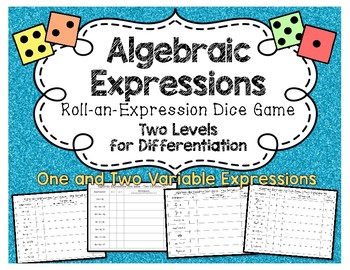Algebraic Expressions Dice Game - Evaluating Expressions - Pre-Algebra
Teaching With Potential
978 Followers
Grade Levels
6th - 9th
Subjects
Resource Type
Standards
CCSS6.EE.A.2
CCSS6.EE.A.2a
CCSS6.EE.A.2b
CCSS6.EE.A.2c
CCSS6.EE.A.3
Formats Included
- PDF
Pages
7 pages
Teaching With Potential
978 Followers
What educators are saying
My students love when there is something fun to do with the skill we are learning. Thank you for making these.
My students were engaged which I appreciate. Anytime we can utilize game play in the assignment, it's a win for everyone.
Description
Practice evaluating algebraic expressions with the fun and engaging addition of dice! You are provided with four game cards:
One variable – basic– A
One variable – advanced – B
Two variables – basic– A
Two variables – advanced – B
The game is simple. Roll the dice to determine what x and y represent. Work space provided to show the substitution of each variable.
It’s that easy!
Wishing you a classfull of curious minds, always!
SCIENCEcerely,
Me
Terms of Use:
All rights reserved. Purchase of this item entitles the purchaser the right to reproduce the pages for individual classroom use only. Duplication for an entire school, an entire school system or for commercial purposes is strictly forbidden without written permission from the author or additional license purchase.
Copyright © 2018 SCIENCEcerely, Me by Erin Hansen
Find my blog at www.SCIENCEcerelyme.com and follow SCIENCEcerely, Me on Pinterest, Facebook, and Instagram @SCIENCEcerely_me.
One variable – basic– A
One variable – advanced – B
Two variables – basic– A
Two variables – advanced – B
The game is simple. Roll the dice to determine what x and y represent. Work space provided to show the substitution of each variable.
It’s that easy!
Wishing you a classfull of curious minds, always!
SCIENCEcerely,
Me
Terms of Use:
All rights reserved. Purchase of this item entitles the purchaser the right to reproduce the pages for individual classroom use only. Duplication for an entire school, an entire school system or for commercial purposes is strictly forbidden without written permission from the author or additional license purchase.
Copyright © 2018 SCIENCEcerely, Me by Erin Hansen
Find my blog at www.SCIENCEcerelyme.com and follow SCIENCEcerely, Me on Pinterest, Facebook, and Instagram @SCIENCEcerely_me.
Total Pages
7 pages
Answer Key
N/A
Teaching Duration
N/A
Report this resource to TPT
Reported resources will be reviewed by our team. Report this resource to let us know if this resource violates TPT’s content guidelines.
Standards
to see state-specific standards (only available in the US).
CCSS6.EE.A.2
Write, read, and evaluate expressions in which letters stand for numbers.
CCSS6.EE.A.2a
Write expressions that record operations with numbers and with letters standing for numbers. For example, express the calculation “Subtract 𝘺 from 5” as 5 - 𝘺.
CCSS6.EE.A.2b
Identify parts of an expression using mathematical terms (sum, term, product, factor, quotient, coefficient); view one or more parts of an expression as a single entity. For example, describe the expression 2 (8 + 7) as a product of two factors; view (8 + 7) as both a single entity and a sum of two terms.
CCSS6.EE.A.2c
Evaluate expressions at specific values of their variables. Include expressions that arise from formulas used in real-world problems. Perform arithmetic operations, including those involving whole-number exponents, in the conventional order when there are no parentheses to specify a particular order (Order of Operations). For example, use the formulas V = s³ and A = 6 s² to find the volume and surface area of a cube with sides of length s = 1/2.
CCSS6.EE.A.3
Apply the properties of operations to generate equivalent expressions. For example, apply the distributive property to the expression 3 (2 + 𝘹) to produce the equivalent expression 6 + 3𝘹; apply the distributive property to the expression 24𝘹 + 18𝘺 to produce the equivalent expression 6 (4𝘹 + 3𝘺); apply properties of operations to 𝘺 + 𝘺 + 𝘺 to produce the equivalent expression 3𝘺.





